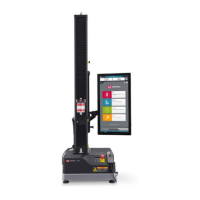Chapter: Assemble the load string
76 M10-17410-EN
• Make sure that the load cell is verified for the range of force that you anticipate for
your testing
• If there is a choice between two different load cells because of overlapping ranges:
• select a higher capacity load cell when you require minimum deflection of the
load cell
• select a lower capacity load cell when you require maximum long term balance
or stability
If you don’t know the tensile strength of the material, refer to a Properties of Materials
handbook to obtain an approximate strength. To calculate the tensile strength in force
units for a specimen, use the following equation:
tensile strength x cross-sectional area
For example, for a standard ASTM tensile specimen (0.502 in wide, 0.125 in thick)
made with a material of tensile strength 5200 psi (from Materials Handbook) perform
the following calculation:
5200 x 0.502 x 0.125 = 328 lbf
This produces a recommendation of the 5 kN (1000 lb, 500kg) capacity load cell.
If you cannot determine an approximate value of tensile strength, use the highest
capacity load cell rated for the frame. Perform a preliminary test at a very slow speed to
obtain the load range required. You can then determine if a lower capacity load cell can
provide improved resolution.
Table 8 on page 76 and Table 9 on page 77 list the load cells that are recommended
for use with these frames.
If you have a load cell that is not listed, contact Instron for advice on compatibility and
adapters that may be available for your load cell.
Table 8. 2530 Series
Catalog no.
Capacity
N (lbf)
Effective length
mm (in) Mechanical fitting Interface size
2530-5N 5 N (1) 48 (1.89) 2.5 mm clevis pin
and 6 mm clevis pin
OOf
Of
2530-10N 10 N (2.25) 48 (1.89) 2.5 mm clevis pin
and 6 mm clevis pin
OOf
Of
2530-50N 50 N (11) 48 (1.89) 2.5 mm clevis pin
and 6 mm clevis pin
OOf
Of

